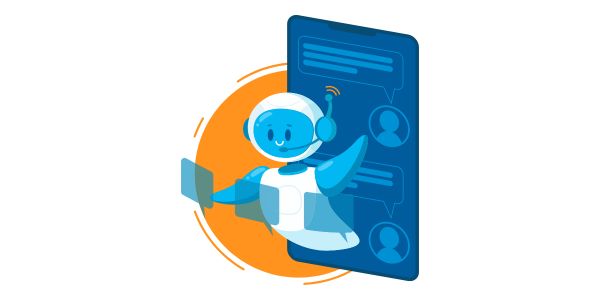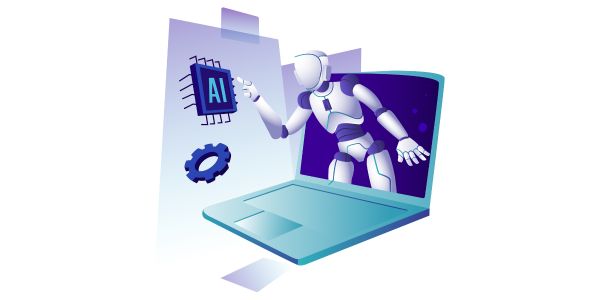Address
304 North Cardinal St.
Dorchester Center, MA 02124
Work Hours
Monday to Friday: 7AM - 7PM
Weekend: 10AM - 5PM
Address
304 North Cardinal St.
Dorchester Center, MA 02124
Work Hours
Monday to Friday: 7AM - 7PM
Weekend: 10AM - 5PM

The landscape of customer service and business interactions is undergoing a significant metamorphosis, largely due to the advent of AI-powered chatbots. These advanced conversational tools, equipped with the capacity to understand and mimic natural language, form the core of the top chatbot trends in 2023. Exploring the vibrant chatbot market trends uncovers how they’re enriching our lives and revolutionizing business practices this year.
From development, applications, adoption, benefits, and the future outlook is staggering. So let’s get started,
AI has steadily carved a prominent space in various businesses, transforming operational processes and customer interactions. Nearly half of organizations now rely on them for customer care, as per Gartner, signifying a shift from traditional customer care methods. The growth of the chatbot market is another testament to the rise. With users increasingly engaging with digital assistants, the market size of Conversational AI is projected to grow significantly.
The chatbot market is expected to grow over $994 million in 2023.
Tidio
Clients have a favorable tilt towards businesses that integrate bot assistance. Nearly half – 47%, to be exact – are amenable to making purchases via a bot. The latest data in marketing suggests a significant trust, with a majority of buyers considering them the optimal means of interacting with businesses.
Customers prefer businesses to offer bot support and 47% of users are open to purchasing items through a bot.
Businessinsider
Chatbot trends indicate a pivotal role in enriching customer experience. Their real-time responses, non-stop availability, and the capacity to manage multi-turn conversations underline the amazing benefits of AI.
The impact of AI is set to become mainstream as integration in operations becomes more and more common.
23% of customer service companies are currently using AI chatbots.
Salesforce
This trend has been predicted by Gartner, a renowned research and advisory company. They anticipate a future where almost half of organizations will use them for customer service.
47% of organizations will use chatbots for customer care, and 40% will deploy virtual assistants.
Gartner
These figures point to a paradigm shift in service where AI will play a central role in transforming the customer journey by providing immediate responses, personalized assistance, and 24/7 support.
Conversational AI has immense potential for market growth. This form of AI enables computer systems to simulate human conversation, thus enhancing customer engagement and service delivery. Cognizant, a multinational technology company, projects the market size of conversational AI to be massive. This indicates a growing acceptance and adoption of conversational AI in various business processes.
The market size of Conversational AI is expected to reach USD$1.3 billion by 2025, growing at a CAGR of 24%.
Cognizant

Different sectors have different chatbot adoption rates. While top chatbot trends indicate that they are becoming more widespread, their adoption varies across sectors.
For instance, B2B companies are adopting at a higher rate than their B2C counterparts. The growing trend of AI in business underscores the importance of chatbots in business-to-business interactions.
58% of B2B companies actively use chatbots, compared to 42% of B2C companies.
Relay
Chatbots have found utility across various sectors. The top industries capitalizing on the advantages include real estate, travel, education, healthcare, and finance, as reported by Service Bell. The wide-ranging applicability in these sectors signifies their potential to revolutionize business operations and customer service across multiple industries.
The top 5 industries profiting from the incorporation of chatbots are real estate (28%), travel (16%), education (14%), healthcare (10%), and finance (5%).
Chatbots Life
Chatbot trends 2023 projects the widespread adoption of chatbot technology across different regions, reiterating the increasing influence of AI in everyday life.
The adoption isn’t limited to a specific region; it’s a global trend. According to Tidio, countries like the United States, India, Germany, the UK, and Brazil are embracing the latest developments. In fact, these countries lead the top chatbot trends, with various industries benefiting significantly.
Roughly 1.5 billion people are using chatbots. The number of chatbot users worldwide is going to continue growing, and by 2027, chatbots are expected to become the primary customer service channel for a quarter of businesses.
Tidio
E-commerce is one industry that has significantly benefitted from the deployment of bots. Juniper Research estimates that by 2023, the value of eCommerce transactions processed by bots will hit $112 billion. This impressive figure indicates the potential to revolutionize shopping experiences, fostering convenient, personalized, and efficient transactions.
The projected value of chatbot eCommerce transactions by 2023 is $112 billion.
Juniper Research

The transformative potential of digital assistance in enhancing customer experience cannot be understated. Customers appreciate the 24/7 availability, as revealed by Outgrow. The data also suggest that a substantial majority of web users have had positive interactions. The capacity to deliver swift responses further underscores their pivotal role in delivering superior customer experiences.
Chatbots are appreciated by customer service reps as they tackle 70-80% of basic inquiries, liberating reps from phone calls and enabling more time for proactive support, resulting in happier customers.
HubSpot
The cost and budget benefits are remarkable. They are projected to save businesses significant work hours, and their cost per interaction is significantly lower than traditional service methods. The anticipated value of top chabot trends in eCommerce transactions further illustrates their economic advantage. These factors make them a highly efficient tool for businesses.
Chatbots are projected to save businesses up to 2.5 billion hours of work by 2023. The average cost of one chatbot interaction is $0.50-0.70.
Juniper Research
Chatbots provide a cost-effective solution for businesses, reducing overheads by streamlining operations, automating repetitive tasks, and offering automated customer support without the need for additional staff.
It is predicted that chatbots can save businesses $8 billion.
Invespro.com
The automated assistants significantly reduce expenses by handling multiple inquiries at the same time. Thus, they reduce the need for numerous service agents. The savings, coupled with the improved efficiency in handling questions, make them a valuable addition to any customer support team.
Chatbots can save up to 50% in customer support costs.
Invespro.com

And one more statistic to prove how much businesses can save money.
Businesses can reduce customer service costs by up to 30% by deploying a conversational chatbot.
Chatbots Magazine
Digital tools significantly reduce customer support costs by handling multiple inquiries simultaneously, thereby reducing the need for numerous customer service agents. The savings, coupled with improved efficiency in handling customer service, make them a valuable addition to any customer support team.
95% of consumers believe that customer service is going to be a major beneficiary of chatbots.
Invesp
CNBC predicts a future where bots will manage the majority of customer needs. By 2024, bots are expected to handle between 75-90% of the questions. This showcases the increasing capabilities of bots to manage customer inquiries efficiently and highlights the potential for significant customer service transformation.
75-90% of queries are projected to be handled by bots by 2024.
CNBC

These intelligent digital helpers are not only efficient in handling queries but also effective in resolving them. With most customer queries being resolved in a limited number of messages, the efficiency is clear. The predicted increase in the share of queries handled further emphasizes their role in facilitating seamless customer experiences.
The #1 predicted use case for chatbots is “getting a quick answer in an emergency”. The #2 use case is “resolving a complaint or question.
Drift
The digital payment landscape has seen significant shifts in recent years. The primary driver behind this change is the customer’s desire for a seamless transaction experience. As digitization offers the convenience of instant connectivity, the preference for digital payments continues to expand.
28% of the users in the US have already switched to voice payments.
haptik
Chatbots are redefining marketing strategies with their ability to deliver personalized messages, offer product recommendations, and interact with customers at any time of day. These virtual assistants collect invaluable data about customer behavior, providing insights that can be used to refine marketing campaigns and drive sales. With chatbots, businesses can engage customers in a more interactive and responsive way, revolutionizing the traditional marketing landscape.
A chatbot campaign has a 98% open rate.
SCORE
The prominence of these AI tools is set to overtake traditional mobile app development in terms of annual expenditure. This indicates a shift in business strategy from the development of standalone mobile apps to the deployment of bots that can integrate with existing platforms and offer real-time, personalized interaction with customers.
More than 50% of enterprises will spend more per annum on bots and their creation than traditional mobile app development.
Gartner
Automated bots are getting smarter thanks to the ongoing advancements in Natural Language Processing (NLP). Innovations such as the ChatGPT AI writing assistant are enhancing the contextual understanding, minimizing redundancy, and fostering a more engaging interaction with users.
According to the latest available data, ChatGPT currently has over 100 million users. And the website currently generates 1.8 billion visitors per month.
The Guardian, Similarweb
The sophistication of AI technology has enabled the creation of chatbots that mimic human conversations more accurately, thereby offering a more personalized user experience. The chatbot future trends predict a burgeoning market size, demonstrating the immense potential of the technology in reshaping customer-business interactions.
On average, chatbots chats have almost 90% satisfaction rates, which is whole 2% higher than the rate for live chat conversations.
Comm100
According to a report by Goldman Sachs, AI might do many jobs by itself in the future. In office jobs, AI could do almost half of the work. It could also do a lot of work in legal jobs and in jobs that involve designing buildings. But in jobs where you need to use your hands a lot, like construction, fixing things, and maintenance, AI won’t be taking over many jobs.
AI could automate 300 million jobs.
ZDNet
The common assumption among business owners is that human interaction is irreplaceable in ensuring a superior customer experience. Yet, this may not necessarily hold true in today’s digital landscape. HubSpot revealed that a substantial percentage of consumers are impartial, expressing no preference between interacting with a chatbot or a human agent.
40% of consumers have no preference, whether they engage with a chatbot or a human agent.
HubSpot
Technological advancements are expanding the applicability through integration with voice assistants. In 2023, the number of voice chatbots is predicted to rise to over 8 billion (Tidio). Businesses have an opportunity to offer personalized, hands-free experiences to their customers through this seamless integration.
50% of the US population uses voice search features daily, and 34% uses them at least once a week.
Oberlo
Voice-driven AI is becoming increasingly prevalent. Consumers are growing accustomed to voice-activated digital assistants like Google’s Assistant, Amazon’s Alexa, and Apple’s Siri. Forbes highlights the rising influence of voice-driven chatbots on digital user experiences.
More than 50% of all searches will be voice-driven.
Forbes

As technology evolves, they are becoming more human-like, leading to more natural and engaging customer interactions.
74% of internet users prefer using chatbots when looking for answers to simple questions.
PSFK
Insights from recent studies suggest that the modern consumer is increasingly drawn toward interactions with bots. They find convenience and efficiency in using chatbots to sort out minor concerns or when they’re racing against time. The notion of receiving assistance from a digital interface doesn’t bother them as long as it ensures swift responses and swift resolutions to their queries.
69% of consumers prefer to use chatbots because they provide instant responses.
Salesforce
Millennials, known for their tech savviness, show a significant inclination towards brands using the latest tech. In fact, one of the top chatbot trends is that the younger generations are completely open to new tech.
60% of millennials say they have used chatbots. 70% of them say they had a positive experience.
Forbes
40% of millennials claim to engage with bots on a daily basis.
Mobile Marketer
Millennials are likely to purchase products and services from brands that are adopting new tech quickly. This underscores the crucial role in shaping consumer behavior, especially among the younger demographic.
67% of US millennials said they are likely to purchase products and services from brands using a chatbot.
Chatbots Magazine
With the market expected to reach considerable value by the end of the decade, the future looks bright. AI chatbots are witnessing an accelerated growth trajectory. Their integration into business models, irrespective of scale, is a testament to the growth of AI.
The global chatbot marketing revenue reached $83.4 million this year.
Statista
Predictions are that businesses’ spending will soon exceed that of traditional mobile app development. This projected growth and business adoption highlight the increasing recognition as strategic investments. Additionally, chatbot trends reveal a quick adoption rate of chatbots by smaller businesses, reflecting how they are driving tech transformations.
The chatbot market is expected to reach $3 billion by the end of the decade.
Gartner
Chatbot user growth and benchmarks suggest an unprecedented surge in AI chatbot market trends. This is driven by the demand for personalized customer experiences and efficient business operations. As advancements in technology continue, they will increasingly drive business success. Begin by learning how much does it cost to develop a chatbot?
By embracing AI chatbot technology, businesses can stay ahead of the curve and unlock new growth opportunities in the vibrant digital landscape.